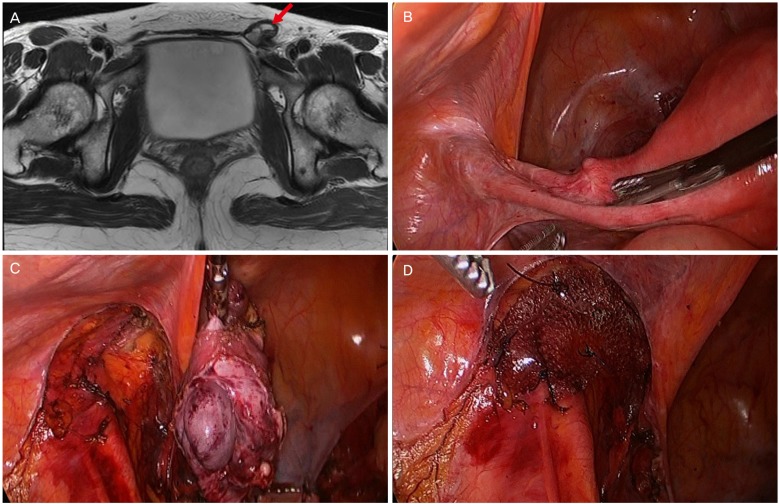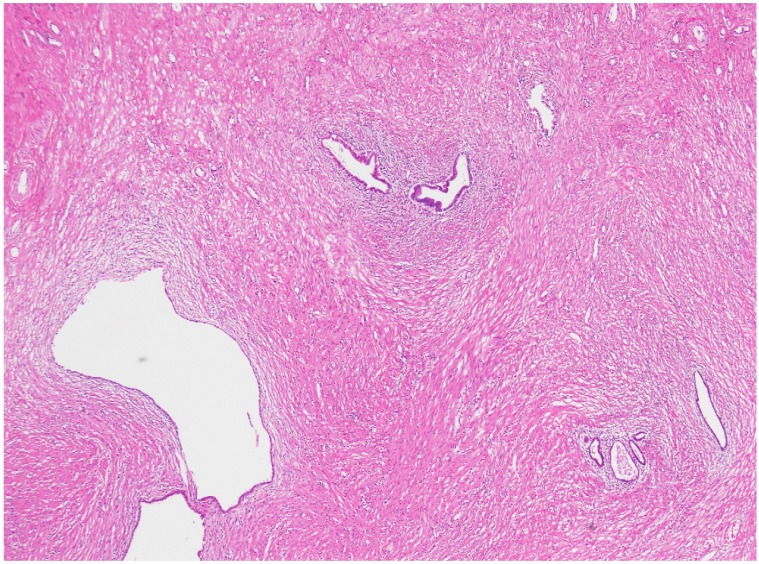 |
 |
- Search
| Obstet Gynecol Sci > Volume 57(6); 2014 > Article |
Abstract
Indirect inguinal hernia containing an ovary is a rare condition, especially in adult women who do not have any other genital tract anomalies. In addition, inguinal hernia containing an ovary and endometriosis is exceedingly rare. In the present report, we describe a case of indirect inguinal hernia containing an ovary, fallopian tube, and endometriosis. Laparoscopic repair was performed successfully using polypropylene mesh for the treatment of the inguinal hernia.
Most cases of inguinal hernia containing an ovary and fallopian tubes reported to date occurred in infants and were often accompanied by other congenital anomalies of the genital tract [1]. However, inguinal ovaries can occur rarely in adult women without any other genital anomalies. Moreover, inguinal ovary accompanying other ovarian diseases is extremely rare. Ozkan et al. [2] reported the only case of inguinal ovary with other ovarian pathology in which a right sliding indirect inguinal hernia containing a paraovarian cyst and fallopian tube was noted. In addition, inguinal hernia containing endometriosis is extremely rare [3,4]. Herein we report a case of an indirect inguinal hernia containing endometriosis, an ovary, and fallopian tube in an adult woman without genital anomalies, which was successfully repaired laparoscopically using polypropylene mesh.
A 44-year-old multiparous patient was scheduled to undergo total laparoscopic hysterectomy for the treatment of microinvasive cervical cancer. She reported a lump in the left groin that became more apparent during menstruation, movement, and constipation. She had no specific medical or surgical history. Moreover, no genital anomalies were found on physical examination. A magnetic resonance imaging (MRI) examination of the pelvis demonstrated a 4├Ś3 cm cystic structure in the left inguinal area (Fig. 1A).
The intervention was performed laparoscopically. The uterus and right ovary, fallopian tube, and round ligament appeared normal. However, the left ovary and a portion of the left fallopian tube were herniated through the inguinal canal (Fig. 1B). After the left ovary was mobilized, the left adnexa was removed. Furthermore, a defect of the parietal peritoneum in the inguinal internal ring area was identified (Fig. 1C). Polypropylene mesh was used to repair the hernia and was anchored to the anterior abdominal wall as well as Cooper's ligament using laparoscopic sutures to prevent migration (Fig. 1D). Finally, the peritoneal flap was closed over the mesh by suturing to prevent adhesion of the intra-abdominal structures to the mesh. The patient had an uneventful postoperative course and was discharged on day 3. A histopathological examination confirmed the presence of endometriosis containing endometrial glands, with stromal cells and scattered hemosiderin-laden macrophages within fibroadipose tissue (Fig. 2).
The inguinal canal in females not as well demarcated as in males. Several different structures normally pass through it, including the round ligament of the uterus, a vein, an artery from the uterus that forms a cruciate anastomosis with the labial arteries, and extra peritoneal fat [5]. Most cases of inguinal ovary have been reported in pediatric patients with other genital tract anomalies [1]. Inguinal ovaries in adult women are rarely reported; in fact, only 12 cases were identified in a recent review article [6]. In a retrospective review of 1,950 cases of inguinal hernia, ovaries and fallopian tubes accounted for 2.9% of the unusual contents of hernia sacs [2]. Okada et al. [7] suggested a hypotheses for this type of inguinal hernia: weakness of the broad ligaments or ovarian suspensory ligaments can contribute to ovarian herniation into the inguinal ring. This can be aggravated by high intra-abdominal pressure caused by lifting heavy objects or constipation.
Inguinal endometriosis is also a rare condition. Candiani et al. [8] reviewed 958 patients with endometriosis and reported that only 0.6% of them had inguinal endometriosis. Furthermore, only a few case reports have demonstrated an inguinal ovary accompanied by endometriosis [3,4]. A differential diagnosis is essential in cases of suspected inguinal masses. Computed tomography, MRI, and ultrasonography are useful diagnostic tools; however, MRI is more accurate than computed tomography for the detection of inguinal endometriosis [9].
Most cases of inguinal ovary and endometriosis are managed by wide excision [1,2,8,9]. Only a few case reports have described laparoscopic management for the treatment of inguinal ovary or endometriosis [6,10]. The laparoscopic approach may be suitable for patients in terms of fast recovery and cosmetic outcomes. In addition, collaboration with general surgery department is important to prevent recurrence of inguinal hernia.
In conclusion, we report a case of inguinal ovary with endometriosis. In this case, a laparoscopic approach was successfully performed and had the advantages of fast recovery and a favorable cosmetic outcome; therefore, the laparoscopic approach should be considered for the treatment of inguinal ovary with endometriosis.
References
2. Ozkan OV, Semerci E, Aslan E, Ozkan S, Dolapcioglu K, Besirov E. A right sliding indirect inguinal hernia containing paraovarian cyst, fallopian tube, and ovary: a case report. Arch Gynecol Obstet 2009;279:897-899. PMID: 18836735.


3. Kamio M, Nagata T, Yamasaki H, Yoshinaga M, Douchi T. Inguinal hernia containing functioning, rudimentary uterine horn and endometriosis. Obstet Gynecol 2009;113:563-566. PMID: 19155958.


4. Kiyak G, Ergul E, Sarikaya SM, Yazgan A. Endometriosis of the groin hernia sac: report of a case and review of the literature. Hernia 2010;14:215-217. PMID: 19590815.


5. Gurer A, Ozdogan M, Ozlem N, Yildirim A, Kulacoglu H, Aydin R. Uncommon content in groin hernia sac. Hernia 2006;10:152-155. PMID: 16172801.


6. Josefsson ML, Mitra S, Gupta S. Inguinal ovary in adult women-case report and literature review. Springerplus 2013;2:545PMID: 24255844.



7. Okada T, Sasaki S, Honda S, Miyagi H, Minato M, Todo S. Irreducible indirect inguinal hernia containing uterus, ovaries, and Fallopian tubes. Hernia 2012;16:471-473. PMID: 21213003.


8. Candiani GB, Vercellini P, Fedele L, Vendola N, Carinelli S, Scaglione V. Inguinal endometriosis: pathogenetic and clinical implications. Obstet Gynecol 1991;78:191-194. PMID: 2067761.

9. Kim da H, Kim MJ, Kim ML, Park JT, Lee JH. Inguinal endometriosis in a patient without a previous history of gynecologic surgery. Obstet Gynecol Sci 2014;57:172-175. PMID: 24678494.



10. Jimenez JS, Barbero P, Tejerizo A, Guillen C, Strate C. A laparoscopic approach to Nuck's duct endometriosis. Fertil Steril 2011;96:e103-e105. PMID: 21719002.


Fig.┬Ā1
(A) Magnetic resonance imaging of the pelvis showing a 4├Ś3 cm cystic structure in the left inguinal area (red arrowhead). (B) Laparoscopic view of herniation of the left ovary and a portion of the left fallopian tube in the inguinal canal. (C) Laparoscopic view of defect of the parietal peritoneum in the inguinal internal ring area. (D) Laparoscopic view of polypropylene mesh used to repair the hernia.

-
METRICS

-
- 2 Crossref
- 2,466 View
- 28 Download
- Related articles in Obstet Gynecol Sci
-
Inguinal hernia of ovary and fallopian tube in adult woman.2006 September;49(9)




















